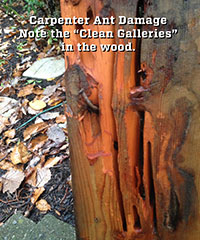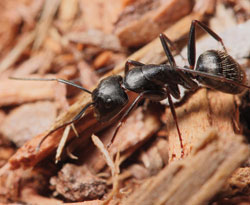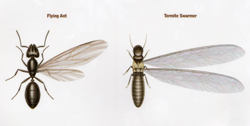Carpenter Ant Control in New Jersey

Carpenter ants can cause dramatic damage to organic materials, such as carving deep "galleries" in wood.
What are carpenter ants?
Carpenter ants, prevalent in New Jersey, are notorious for damaging wood structures. With eight species of varying sizes and colors in the region, the black carpenter ant is the most common and largest. These ants excavate wood to create space for their colonies, potentially leading to significant damage over time.
Though not as destructive as termites, untreated carpenter ant infestations can cause extensive harm in New Jersey homes. Once established, colonies persist and expand, fueled by available food and moisture. While foraging patterns may change with seasons, the colony remains active within the property. Effective management of carpenter ant infestations requires the removal or destruction of the nest, a task best handled by professional pest control services to ensure long-term resolution.
When and where are carpenter ants active?
 In New Jersey, carpenter ants typically become active from May to October, with peak activity observed in July. Detection of carpenter ants during winter or early spring suggests an indoor nest, while sightings during peak season may indicate scouting behavior from an external nest. Properties nestled in wooded areas are particularly vulnerable to carpenter ant infestations, as these ants commonly inhabit urban shade trees and can travel up to 100 yards in search of food and moisture-often finding their way into nearby homes.
In New Jersey, carpenter ants typically become active from May to October, with peak activity observed in July. Detection of carpenter ants during winter or early spring suggests an indoor nest, while sightings during peak season may indicate scouting behavior from an external nest. Properties nestled in wooded areas are particularly vulnerable to carpenter ant infestations, as these ants commonly inhabit urban shade trees and can travel up to 100 yards in search of food and moisture-often finding their way into nearby homes.
Carpenter ants frequently establish satellite colonies around or within residences, necessitating vigilant monitoring of both indoor and outdoor areas for signs of infestation. The goal is not to eliminate carpenter ants from the property entirely, as they naturally inhabit outdoor environments. Instead, effective pest control aims to prevent carpenter ants from infiltrating and nesting inside the home, safeguarding the property from structural damage. Professional pest control services can help implement strategies to maintain this barrier between the ants' natural habitat and the home.
How can you identify carpenter ants?
Carpenter ants are easily recognizable due to their large size and uniform dull black coloration. Worker ants can grow up to half an inch in length. Like all insects, they possess six legs and three distinct body segments: a head, thorax (trunk), and abdomen. When viewed from the side, their thorax has a distinct "hunchback" shape. Protected by a tough exoskeleton, their bodies feature a shell-like covering. Carpenter ants use their antennae, or feelers, for various functions including communication, detecting smells, and exploring their environment.
Equipped with strong jaws and pinchers, carpenter ants can chew through wood with ease. While larger workers are capable of delivering a painful bite, unlike some other ant species like fire ants, they do not possess a venomous sting. Furthermore, carpenter ants do not transmit diseases, distinguishing them from disease-carrying pests like ticks or mosquitoes. However, their ability to cause structural damage to wooden structures makes them a significant concern for homeowners. Professional pest control services can effectively address carpenter ant infestations and protect properties from potential damage.
Recent Testimonials
What's the difference between winged carpenter ants and winged termites?
An important distinction for homeowners is whether the insect spotted inside their house is a winged carpenter ant or a winged termite. Having carpenter ants is a problem. But having termites is certainly a bigger problem. We don’t think of ants or termites as winged insects – and that is true when it comes to the workers. However, female and male reproductive ants and termites (“swarmers”) that leave the colony to start their own nests do have wings.
What can Cowleys Pest Services do for homeowners to remove a carpenter ant infestation?
Eliminating a carpenter ant infestation can be a difficult and challenging task. Often, the nests are often concealed in wall voids, ceilings, subfloors, attics or hollow doors. The top pest control services implement Integrated Pest Management (IPM) protocols that emphasize prevention and the judicious and selective use of chemical applications as part of an overall cost-effective long-term treatment plan.
Begin with a thorough inspection
The pest control professional must inspect the structure to determine where there are nests inside the structure as well as the points of entry from outside nests. It is important to identify the species of carpenter ants causing the problem, to find the nests – both inside the structure as well outside. The nest must be located and removed. Anything else is ineffective. Although it may “feel good” to kill a few of the pesky ants, spraying a home-use insecticide on surfaces where ants travel or congregate such as along baseboards or in holes or cracks in the walls and floors has little long-term effect. It may reduce the frequency and number of ants that you see, but is completely ineffective in eliminating the nest.
Carpenter ants live in large, complex colonies. There is one queen who does the egg-laying and thousands of workers with special functions. Some care for the eggs, larvae, and pupae in the nest, others guard the nest, some dig out the nest, and others forage for food to bring back to the nest. The workers are sterile – they can’t mate and lay eggs. The ants are so closely related and interdependent that an ant colony, from the perspective of a pest control professional, is the equivalent of a single creature. No one ant or group of ants matter. There are literally thousands of them. A carpenter ant infestation can only be eradicated if the colony is destroyed and the queen is killed. Simply killing the foraging ants is an ineffective short-term solution. Also, once the nest is located and destroyed, the environment for possible re-infestation must be removed. That means replacing the damaged or decayed wood that served as their nest and eliminating moisture problems.
Use IPM
A pest control professional who follows Integrated Pest Management (IPM) protocols can cost-effectively remove the infestation and, more importantly, minimize the chances of a subsequent re-infestation. Nonchemical techniques, such as exclusion and habitat modification, that are combined with strategic applications is the most effective way to rid a home of carpenter ants.
The particular treatments vary depending on the nature and severity of the infestation. A full application consists of applications to wall voids as well as a perimeter spray. A spot treatment may be used for a new or localized infestation. Satellite nests must be eliminated as well because the workers can survive even if their parent colony is destroyed. Dusts are effective for wall voids. Baits can be an effective carpenter ants control measure for carpenter ants because of the ants’ food-sharing behaviors. Other controls must be implemented as well.
Damage repair is key to long-term treatment
Damage repair due to carpenter ants includes removing moisture damage by providing proper ventilation, installing effective vapor barriers, and repair broken or leaky pipes and gutters, replacing seriously damaged wood, caulking or sealing all potential entry points, trimming away vegetation that is surrounding the house including tree branches, shrubs, and vines, removing buried wood such as tree stumps. Grinding stumps isn’t enough. If the wood is not removed, you are giving the ants a perfect nesting environment.
If you suspect a carpenter ant infestation in your home, call the pest control specialists at Cowleys Pest Services. They'll inspect the problem at hand and provide you with long-term solutions. Cowleys Pest Services proudly serves homeowners in Mercer, Ocean, Monmouth, Somerset, & Middlesex County, including Somerset, Edison, Lakewood and the surrounding area.
